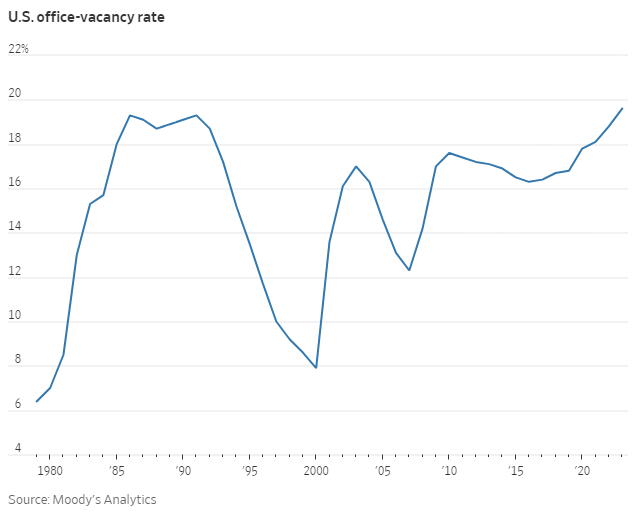Office buildings in America have hit a new vacancy record, with 19.6 percent of office space remaining un-leased in the fourth quarter (Q4). Commentators attribute this to overbuilding in the 1970s and 1980s, as well as the post-pandemic popularity of the remote work employment model.
According to financial rating firm Moody’s Analytics, this is an office space vacancy rate without precedent, the highest since at least 1979—and that’s as far back as Moody’s data goes.
In 2022, 18.8 percent of offices were not being leased. The highest previous peak was 19.3 percent, which was hit in both 1986 and 1991, but nothing higher was reached at any point in the last 45 years.
Learn the benefits of becoming a Valuetainment Member and subscribe today!
Work-from-home or “remote work” policies certainly contributed to the decline. Office attendance rates are hardly even half of what they were in 2019. Even companies that have instated strict measures to bring workers back to the office are seeing lackluster results. And for companies that have employees in the office, many follow a hybrid schedule where Mondays and Fridays see a dearth of foot traffic.
However, COVID-era policies have only acted as an accelerant to a gradual decline that was already underway. Ambitious building projects in the 1950s through the 1980s largely account for the offices that now sit empty, according to the chief executive of real estate brokerage CBRE Mary Ann Tighe. Real estate developers thought the days of huge office spaces would continue unabated as the country continued to modernize and corporatize—but this trend fell off, with many companies preferring smaller buildings. Banks also eagerly signed off on loans for office construction, especially in the South, which had few regulations and cheaper land.
Related: Texas Office Building Vacancy is Higher than New York and San Francisco
That the pandemic is not the only cause of the vacancies is evident from vacancy rates being lower in Europe and Asia, claims the Wall Street Journal. However, it would be helpful to see if work-from-home rates are equivalent between the continents.
According to Worldwide ERC, Asian countries on average have lower remote work rates than Europe and North America. Britain, Canada, and the U.S. have the highest remote work rates.
Shane Devine is a staff writer covering politics, economics, and culture for Valuetainment. Follow Shane on X (Twitter).




















Add comment